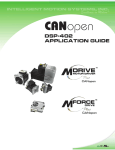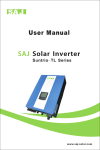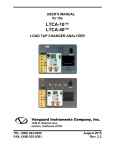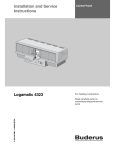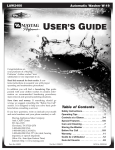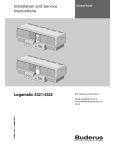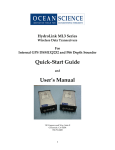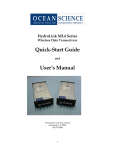Download Intelligent Motion Systems IM481H Computer Drive User Manual
Transcript
T TM intelligent motion systems, inc. Excellence in Motion TM IM481H ULTRA MINIATURE HIGH PERFORMANCE MICROSTEPPING DRIVE OPERATING INSTRUCTIONS 370 N. MAIN ST., PO BOX 457, MARLBOROUGH, CT 06447 PH. (860) 295-6102, FAX (860) 295-6107 Internet: http://www.imshome.com, E-Mail: [email protected] The information in this book has been carefully checked and is believed to be accurate; however, no responsibility is assumed for inaccuracies. Intelligent Motion Systems, Inc., reserves the right to make changes without further notice to any products herein to improve reliability, function or design. Intelligent Motion Systems, Inc., does not assume any liability arising out of the application or use of any product or circuit described herein; neither does it convey any license under its patent rights of others. Intelligent Motion Systems and are trademarks of Intelligent Motion Systems, Inc. TM Intelligent Motion Systems, Inc.’s general policy does not recommend the use of its products in life support or aircraft applications wherein a failure or malfunction of the product may directly threaten life or injury. Per Intelligent Motion Systems, Inc.’s terms and conditions of sales, the user of Intelligent Motion Systems, Inc., products in life support or aircraft applications assumes all risks of such use and indemnifies Intelligent Motion Systems, Inc., against all damages. IM481H Ultra Miniature High Performance Microstepping Drive Revision 05.12.05 © Intelligent Motion Systems, Inc. All Rights Reserved SECTION PAGE 1 LIST OF TABLES AND FIGURES ..................................... 1 2 INTRODUCTION ............................................................... 2 3 PIN ASSIGNMENT AND DESCRIPTION ........................... 3 4 ELECTRICAL SPECIFICATIONS ...................................... 4 5 THERMAL SPECIFICATIONS ........................................... 4 6 MECHANICAL SPECIFICATIONS 6.1 DIMENSIONAL IMFORMATION ........................................ 5 6.2 MOUNTING INFORMATION .............................................. 6 7 OUTPUT CURRENT 7.1 DETERMINING OUTPUT CURRENT ................................. 7 7.2 SETTING OUTPUT CURRENT .......................................... 8 7.3 RESISTOR TABLE ........................................................... 9 8 MOTOR 8.1 MOTOR SELECTION ....................................................... 10 8.2 CONNECTING THE MOTOR ............................................10 9 POWER REQUIREMENTS 9.1 MOTOR POWER ............................................................. 12 9.2 +5 VDC INPUT ................................................................ 13 10LAYOUT AND INTERFACE GUIDELINES ................................. 14 11 MICROSTEP SELECTION ...............................................14 12FULLSTEP OUTPUT SIGNAL ................................................... 16 13TIMING ..................................................................................... 16 14INPUTS .................................................................................... 17 15AUTOMATIC CURRENT REDUCTION ....................................... 18 16FAULT PROTECTION ............................................................... 19 18THERMAL REQUIREMENTS .................................................... 19 19OPTIONS/ACCESSORIES ....................................................... 20 Appendix A - Recommended Cable Configurations ........................ 21 WARRANTY ................................................................................. 30 LIST OF FIGURES Figure 1 DIMENSIONAL INFORMATION .............................. 4 Figure 2 MOUNTING INFORMATION .................................... 6 Figure 3 SETTING OUTPUT CURRENT ................................ 9 Figure 4 MOTOR CONNECTIONS ....................................... 12 Figure 5 POWER CONNECTIONS ......................................14 Figure 6 MICROSTEP RESOLUTION SELECTION ..............16 Figure 7 INPUTS .................................................................18 Figure 8 FAULT IN/RESET - INTERFACE CIRCUIT ..............18 Figure 9 RESET TIMING .....................................................18 Figure 10 MULTIPLE DRIVES - ONE RESET ........................ 18 Figure 11 AUTOMATIC CURRENT REDUCTION ................... 19 LIST OF TABLES Table 1 ELECTRICAL SPECIFICATIONS ............................ 4 Table 2 THERMAL SPECIFICATIONS ................................. 4 Table 3 RESISTOR TABLE ................................................ 10 Table 4 POWER SUPPLY SPECIFICATIONS ....................13 Table 5 MICROSTEP SELECTION ..................................... 15 1 SECTION 2 INTRODUCTION The IM481H is a high performance, yet low cost microstepping driver that utilizes advanced hybrid technology to greatly reduce size without sacrificing features. The IM481H is exceptionally small, easy to interface and use, yet powerful enough to handle the most demanding applications. The IM481H has 14 built in microstep resolutions (both binary and decimal). The resolution can be changed at any time without the need to reset the driver. This feature allows the user to rapidly move long distances, yet precisely position the motor at the end of travel without the expense of high performance controllers. With the development of proprietary and patented circuits, ripple current has been minimized to reduce motor heating common with other designs, allowing the use of low inductance motors improving high speed performance and system efficiency. The IM481H, because of its ultra small size and low cost, can be used to increase accuracy and smoothness in systems using higher step angle motors. In many instances mechanical gearing can be replaced with microstepping, reducing cost and eliminating potential maintenance. OPTIONAL INTERFACE BOARD The INT-481 is a plug on interface board which can be used with the IM481H to facilitate testing or in situations where panel mounting is preferred The INT-481 contains extra circuitry which includes: Opto isolators for step clock, direction, enable, and reset, along with extra fault detection circuits, +5vdc supply, input capacitor, and fault and power LED’s. Wiring is done through a 15 pin screw terminal header. A four position dip switch is supplied for microstep resolution selection. FEATURES •Very Low Cost •Ultra Miniature 1.1” x 2.7” x 0.17” •High Input Voltage (+12 to +48Vdc) •High Output Current (1.5 Amps RMS, 2.3 Amps Peak) •Advanced Hybrid Design •Replaces Mechanical Gearing for Smoothness and Positioning •Designed for High Performance, Low Inductance Stepping Motors •20 KHz Chopping Rate •Up to 10 MHz Step Clock Rate •14 Selectable Microstepping Resolutions that can be changed On-The-Fly. •Up to 51,200 Steps/Rev with a 1.8o Motor •Automatically Switches between Slow and Fast Decay for Unmatched Performance •At Full Step Output 2 SECTION 3 PIN ASSIGNMENT AND DESCRIPTION PIN # 1,2 PIN NAME PIN FUNCTION PHASE A Phase A of the stepping motor is connected between pin 1 and pin 2. See section 8. 3 CURRENT REDUCTION ADJUST Phase current reduction adjustment input. A resistor connected between this pin and pin 4 ( if used to set motor phase current ) will proportionately reduce current in both windings approximately .5 seconds after the last positive edge of the step clock input. See section 15. 4 CURRENT REFERENCE Phase current reference output. A resistor is connected between this 1 mA current source output and the Ground pin ( pin 11 ) to generate the voltage used to set the peak phase current in the motor. See section 7. 5 CURRENT ADJUSTMENT Phase current adjustment input. A voltage applied to this input sets the peak phase current in the motor. See section 7.2. 6 FAULT INPUT A low signal on this input will generate a latched fault condition. See section 16. 710 RESOLUTION SELECT 0-3 Microstep resolution select inputs. Used to select the number of microsteps per step of the motor. See section 11. 11 SUPPLY GROUND Supply voltage ground ( return ). See section 9. 12 +V Supply voltage input. See section 9. 13 RESET INPUT When low, this input will reset the driver ( phase outputs will disable ). When released, the driver will be at its initial state ( phase A off, phase B on ). See section 14. 14 +5V +5Vdc supply input. This supply is used to power the internal logic. The +5Vdc supply should be referenced to pin 11( supply ground ). See section 9.2. 15 STEP CLOCK INPUT A positive going edge on this input advances the motor one increment. The size of the increment is dependent on the microstep select inputs See section 13. 16 DIRECTION INPUT This input is used to change the direction of the motor. Physical direction also depends on the connection of the motor windings. See section 13. 17 ENABLE INPUT This input is used to enable/disable the output section of the driver. When high, the outputs are enabled. However, this input does not inhibit the step clock. Therefore when enabled the outputs will update by the number of clock pulses ( if any ) applied to the driver while it had been disabled. See section 14. 18 ON-FULLSTEP OUTPUT This totem-pole output indicates when the driver is positioned at a full step. This output can be used to count the number of full steps the motor has moved, regardless of the number of microsteps in between. This output is active high. See section 12. 19 FAULT OUTPUT This totem-pole output indicates a short circuit has occurred or a low signal was detected on the Fault input. This output is active high. See section 16 2021 PHASE B Phase B of the stepping motor is connected between pin 20 and pin 21. See section 8. 3 SECTION 4 ELECTRICAL SPECIFICATIONS Table 1 Test Parameters: TA = 25oC,+V = 48v TEST CONDITION MIN TYP MAX UNITS INPUT VOLTAGE ....................................................................................... 12 ....... 45 ........ 48* .......... V PHASE OUTPUT CURRENT ...................................... RMS .......................0.14 ...................1.5 .......... A PHASE OUTPUT CURRENT ..................................... PEAK ..................................................2.3 .......... A QUIESCENT CURRENT (+v, pin 12) .......... INPUTS/OUTPUTS FLOATING ..................... 25 ...................... mA QUIESCENT CURRENT (+5vdc, pin 14) .... INPUTS/OUTPUTS FLOATING ................................... 40 ........ mA ACTIVE POWER DISSIPATION .......................... IOUT = 1A RMS ............................................2.0 ......... W LOW LEVEL INPUT VOLTAGE ............................. ALL INPUTS ..................... .......................0.8 .......... V HIGH LEVEL INPUT VOLTAGE ................... ALL INPUTS EXCEPT RESET......................2.0 ........................ V HIGH LEVEL INPUT VOLTAGE ................................ RESET ...................................2.3 ......................... V INPUT PULL-UP RESISTANCE .................FAULT IN, RES SEL 0-3, ENABLE .......4.4 ......4.7 ........5.0 ........ kΩ INPUT PULL-UP RESISTANCE .....................STEP CLOCK, DIRECTION ........... 2.1 ......2.2 ........2.3 ........ kΩ INPUT PULL-UP RESISTANCE ................................ RESET ....................... 0.9 ......1.0 ........1.1 ........ kΩ LOW LEVEL OUTPUT CURRENT ..................... FAULT, FULLSTEP ................ 24.................................. mA HIGH LEVEL OUTPUT CURRENT .................... FAULT, FULLSTEP .................-2 .................................. mA LOW LEVEL OUTPUT VOLTAGE .......................... IOL =24 mA ...............................................0.4 .......... V HIGH LEVEL OUTPUT VOLTAGE..........................IOH = -2 mA .................... 4.5 .................................... V * INCLUDES BACK EMF OF MOTOR SECTION 5 THERMAL SPECIFICATIONS Table 2 STORAGE TEMPERATURE ................................................ -40 TO +125 OC OPERATING TEMPERATURE................................................ 0 TO +50 OC ‡REAR MOUNTING SURFACE (MAX) ....................................... +70 OC ‡ADDITIONAL COOLING MAY BE REQUIRED TO LIMIT REAR MOUNTING SURFACE Care should be taken when choosing a heatsink to ensure that there is good thermal flow, otherwise hot spots may occur in the IM481H which will reduce the effectivness of the thermal protection. W A R N I N G ! Rear mounting surface of driver contains different voltages and must be keep isolated when attached to a conductive surface ! NOTE: An optional thermal pad ( Part # TI-481 ) and heat sink ( Part # H-481 ) is available for the IM481H 4 MECHANICAL SPECIFICATIONS SECTION 6.1 DIMENSIONAL INFORMATION Dimensions in Inches (mm) IM481H 2.700 (68.6) 2.450 (62.2) 2.225 (56.4) *Wt: 0.512 oz. 14.6 gms. 0.175 2 X Ø 0.150 (3.8)THRU 1.100 (27.9) 65° TYP. Heat Sink This Side 0.175 (4.4) 0.563 (14.3) PIN 1 0.225 (5.7) INT-481 0.058 (1.5) 0.016 (0.4) SQ. 0.100 (25.4) 3.000 (76.2) *Wt: 1.02 oz. 29.0 gms. 0.275 (6.99) 0.920 (23.37) 0.620 (15.75) 2.450 (62.23) 21 21 Pin Right Angle Connector HY481-CN021 1 SW 1 MS0 MS1 MS2 MS3 432 1 JP1 OPTO/+5 V 3 ENOFF/ENON 3 1 Heat Sink This Side 0.575 (14.6) GRN POWER RED LED1 FAULT 19 18 17 14 16 13 15 12 9 11 8 10 5 7 4 3 2 1 1.550 (39.37) 6 1 JP2 2 X Ø 0.143 (3.6 ) Thru H-481 *Wt: 2.40 oz. 68.1 gms. 0.178 (4.5) 0.498 (12.6) 2.872 (72.9) 1.875 (47.6) 0.312 (7.9) 1.312 (33.3) 2 X Ø 0.177 (4.5) Thru 1.100 (27.9) 0.550 (13.9) 0.211 (5.4) 2 X #6-32 Tapped Thru 2.450 (62.2) * Does not include mounting hardware. 5 SECTION 6.2 MOUNTING INFORMATION IM481-H Driver and H-481 Heat Sink Direct Mount on PCB D NOTE: Components are described in the table on the following page. F *4 1 A B 3 C G 0.096 (2.43) PCB Hole Pattern for Direct PCB Mounting H-481 Heat Sink Dimensions are in Inches (mm) 0.063 (1.6) 0.240 (6.1) Ø 0.250 +0.003 / - 0.0 (6.35 +0.08 / - 0.0) 1.875 (47.63) Pin #1 0.100 Typ (2.54 Typ) 0.064 Pad, 0.031 Hole (1.6 Pad, 0.78 Hole) NOTE: The hardware items “A” through “H” are supplied with the H-481 Heat Sink Kit. If the H-481 is not used, the mounting hardware is not supplied. NOTE: The torque specification for the #6-32 INT-481 and IM481H mounting screw is 5.0 - 7.0 in-lbs. (See the hardware list on the following page.) * The Isolating Thermal Pad (TI-481) item “4” is supplied with the INT-481 Interface Board. If the INT-481 is not used, the Thermal Pad must be ordered seperately. WARNING! The Heat Sink mounting surface must be a smooth, flat surface with no burrs, protrusions, cuttings or other foreign objects. WARNING! If you are planning to wash your PCB it must be done prior to adding the IM481H Driver or damage will occur. 6 IM481-H Driver, INT-481 Interface Board, H-481 Heat Sink Panel Mount 3 F E H *4 1 2 0.915 (23.25) Ref. C B A IM481-H Driver, INT-481 Interface Board Panel Mount without Heat Sink *4 1 A B C 2 0.180 (4.57) Ref. Product/Item # Description Qty. 1 IM481H Microstepping Driver 1 2 INT-481 Interface Board 1 1 3 H-481 Heat Sink 4 TI-481 Isolating Thermal Pad 1 A #6-32x5/8" Pan Head Screw 2 2 B #6 Split Lock Washer C #6 Flat Washer, 0.250" OD, 0.145" ID, 0.030" Thick 2 D #8-32x13/8" Pan Head Screw 2 E #8-32x2 Pan Head Screw 2 F #8 Split Lock Washer 2 G #8-32 Internally Threaded Broaching Nut 2 H Spacer, 0.312" OD, 0.171" ID, 0.500" Long 2 * The Isolating Thermal Pad (TI-481) item “4” is supplied with the INT-481 Interface Board. If the INT-481 is not used, the Thermal Pad must be ordered seperately. 7 OUTPUT CURRENT SECTION 7.1 DETERMINING THE OUTPUT CURRENT For any given motor, the OUTPUT CURRENT used for MICROSTEPPING is determined differently from that of a HALF/FULL STEP driver. In the IM481H, a sine/cosine output function is used in rotating the motor. Therefore, when microstepping, the specified phase current of the motor is considered an RMS value. The CURRENT ADJUSTMENT RESISTOR used to set the output current of the IM481H sets the peak output of the sine/cosine waves not the RMS value. Therefore the specified motor current (which is the RMS value) should be multiplied by 1.4 to determine the PEAK value to which the IM481H will be set. EXAMPLE: If a motor has a specified PHASE CURRENT of 0.75 amps per phase, then: 0.75 amps X 1.4 = 1.05 amps peak The Resistor Value = OUTPUT CURRENT X 1000 or in this example: 1.05 X 1000 = 1050 Ω. Table 3 shows commercially available 1% resistors for a given current. NOTE: Stepper motors can be configured as 4, 6, or 8 leads. Each configuration requires different currents. Shown below are the different lead configurations and the procedures to determine their output current. 4 Lead Motors: Multiply the specified phase current by 1.4 to determine the peak output current. 6 Lead Motors: 1) When configuring a 6 lead motor in a half coil configuration ( i.e. connected from one end of the coil to the center tap (high speed configuration)) multiply the specified per phase (or unipolar) current rating by 1.4 to determine the peak output current. 2) When configuring the motor so the full coil is used (i.e. connected from end to end with the center tap floating (higher torque configuration)) use the per phase (or unipolar) current rating as the peak output current. 8 Lead Motors: SERIES CONNECTION: When configuring the motor windings in series, use the per phase (or unipolar) current rating as the peak output current, or multiply the bipolar current rating by 1.4 to determine the peak output current. PARALLEL CONNECTION: When configuring the motor windings in parallel, multiply the per phase (or unipolar) current rating by 1.96 or the bipolar current rating by 1.4 to determine the peak output current. NOTE: After determining the peak output current, use table 4 to choose the proper current reference resistor value. 8 SECTION 7.2 SETTING OUTPUT CURRENT The OUTPUT CURRENT on the IM481H is set by applying a voltage to pin 5 (current adjustment). The output current is set as follows: PEAK OUTPUT CURRENT (Amps) = Volts applied to pin 5 EXAMPLE: 1.4 volts applied to pin 5 will set the peak output current of the IM481H to 1.4 amps per phase. To generate the reference voltage needed to set the peak output current of the driver, a 1mA current source is provided (pin 4, Current Reference ). By connecting a resistor ( 1/8 watt or higher ) between pin 4 and pin 11 ( Ground ) a reference voltage is generated. Pin 4 is then connected to pin 5 ( Current Adjustment) to set the peak per phase output current of the driver ( See Figure 3 ). The relationship between the output current and the resistor value is as follows: PEAK OUTPUT CURRENT (Amps) x 1000 = Resistor Value (Ohms) EXAMPLE: To set the peak output current of the IM481H to 1.4 Amps: 1.4 ÷ .001 = Resistor Value = 1400 . Table 3 shows the standard 1% resistor values with respect to the peak output current. When using the Current Reference output to set the output current of the IM481H, care should taken to keep the connections as short as possible to help minimize the noise coupled into the driver. Supply Ground Current Reference Current Adjustment NOTE: 1 2 3 4 5 6 7 8 9 10 11121314151617181920 21 Current Adjustment Resistor Figure 3 WARNING! A Current Adjustment Resistor is always necessary to keep the Driver and/or Motor in safe operating range. DO NOT operate the IM481H Driver without a Current Adjustment Resistor! 9 SECTION 7.3 RESISTOR TABLE Table 3 PEAK OUTPUT CURRENT (AMPS) REFERENCE (VOLTS) RESISTOR VALUE (1%) (OHMS) 0.20 ................................ 0.20 ............................. 200 0.25 ................................ 0.25 ............................. 249 0.30 ................................ 0.30 ............................. 301 0.35 ................................ 0.35 ............................. 348 0.40 ................................ 0.40 ............................. 402 0.45 ................................ 0.45 ............................. 453 0.50 ................................ 0.50 ............................. 499 0.55 ................................ 0.55 ............................. 549 0.60 ................................ 0.60 ............................. 604 0.65 ................................ 0.65 ............................. 649 0.70 ................................ 0.70 ............................. 698 0.75 ................................ 0.75 ............................. 750 0.80 ................................ 0.80 ............................. 806 0.85 ................................ 0.85 ............................. 845 0.90 ................................ 0.90 ............................. 909 0.95 ................................ 0.95 ............................. 953 1.00 ................................ 1.00 ........................... 1000 1.05 ................................ 1.05 ........................... 1050 1.10 ................................ 1.10 ........................... 1100 1.15 ................................ 1.15 ........................... 1150 1.20 ................................ 1.20 ........................... 1210 1.25 ................................ 1.25 ........................... 1240 1.30 ................................ 1.30 ........................... 1300 1.35 ................................ 1.35 ........................... 1330 1.40 ................................ 1.40 ........................... 1400 1.45 ................................ 1.45 ........................... 1430 1.50 ................................ 1.50 ........................... 1500 1.55 ................................ 1.55 ........................... 1540 1.60 ................................ 1.60 ........................... 1580 1.65 ................................ 1.65 ........................... 1650 1.70 ................................ 1.70 ........................... 1690 1.75 ................................ 1.75 ........................... 1740 1.80 ................................ 1.80 ........................... 1780 1.85 ................................ 1.85 ........................... 1820 1.90 ................................ 1.90 ........................... 1870 1.95 ................................ 1.95 ........................... 1960 2.00 ................................ 2.00 ........................... 2000 2.05 ................................ 2.05 ........................... 2050 2.10 ................................ 2.10 ........................... 2100 W A R N I N G ! Although stepping motors will run hot when configured correctly, damage may occur to a motor if a higher than specified current is used. Most specified motor currents are maximum values. Care should be taken when exceeding these ratings. 10 MOTOR SECTION 8.1 MOTOR SELECTION The IM481H is a Bipolar driver which works equally well with both Bipolar and Unipolar motors, ( i.e. 8 and 4 lead motors and 6 lead center tapped motors (see section 8.2, Connecting the Motor)). To maintain a given set motor current, the IM481H chops the voltage using a constant chopping frequency and a varying duty cycle. Duty cycles that exceed 50% can cause unstable chopping. This characteristic is directly related to the motor’s winding inductance. To avoid this situation, it is necessary to choose a motor with a low winding inductance. The lower the winding inductance, the higher the step rate possible. The maximum per phase motor inductance for the IM481H is calculated as follows: Max. per Phase Inductance (mH) = 2 x Supply Voltage ÷ 10 NOTE: In calculating the maximum phase inductance, when using an unregulated power supply, the minimum supply output voltage should be used. Since the IM481H is a constant current source, it is not necessary to use a motor that is rated at the same voltage as the supply voltage. What is important is that the IM481H is set to the motor’s rated current. The higher the voltage used the faster the current can flow through the motor coils. This in turn means a higher step rate. Care should be taken not to exceed the maximum voltage of the driver. Therefore in choosing a motor for a system design, the best performance for a specified torque is a motor with the lowest possible winding inductance used in conjunction with the highest possible driver voltage. SECTION 8.2 CONNECTING THE MOTOR Phase A of the Stepping Motor is connected between pins 1 and 2. Phase B of the Stepping Motor is connected between pins 20 and 21. The following drawings in figure 4 illustrates the connection of 4,6, and 8 Lead Stepping Motors to the IM481H Driver. NOTE: To reduce the transmission of EMI from the motor cables, a twisted pair sheilded cable is recommended if the driver to motor cabling is in excess of one foot. Motor leads should not exceed 100 feet. Refer to Section 10, Recommended Wiring, for further information. NOTE: The physical direction of the motor with respect to the direction input will depend on the connection of the motor windings. To reverse the direction of the motor with respect to the direction input, switch the wires on either phase A or phase B outputs. WARNING! Do not connect or disconnect the AC power leads or the motor leads with power applied! 11 MOTOR CONNECTIONS 1 1 2 2 PHASE A PHASE A PHASE B PHASE B 20 20 21 21 8 LEAD MOTOR SERIES CONNECTION 8 LEAD MOTOR PARALLEL CONNECTION 1 1 2 NC 2 NC PHASE A PHASE A PHASE B PHASE B NC 20 20 21 21 6 LEAD MOTOR HIGHER SPEED CONFIGURATION ( HALF COIL ) NC: NO CONNECTION NC 6 LEAD MOTOR HIGHER TORQUE CONFIGURATION ( FULL COIL ) NC: NO CONNECTION 1 2 PHASE A PHASE B 20 21 4 LEAD MOTOR Figure 4 12 POWER REQUIREMENTS SECTION 9.1 MOTOR POWER Pins 11 (ground), and 12 (+V) are used to connect the motor DC power to the IM481H. Two local capacitors are needed, connected between pins 11 and 12 and located as close to the pins as possible, to insure stable operation. The first capacitor is a low impedance, aluminum electrolytic. The continuous operating voltage of the capacitor should exceed the maximum supply voltage as well as any additional voltage caused by the motors back EMF. The value of the capacitor should be approximately 150 microfarads for every 1 amp of peak per phase output current. EXAMPLE: For a peak output current of 1.4 amps, and a supply voltage of 45 volts, a 220uf 50v capacitor is recommended. Along with the aluminum electrolytic, a 0.1 microfarad ceramic capacitor must be used to filter out high frequency noise. It should be located between the IM481H’s power input pins and the aluminum electrolytic capacitor. The continuous operating voltage of the capacitor should exceed the maximum supply voltage as well as any additional voltage caused by the motors back EMF. POWER SUPPLY SPECIFICATIONS Table 4 Recommended Type: ..............Unregulated DC. Ripple Voltage ............................. ±10% max. Output Voltage ......................... +12 to +45Vdc *Output Current.................. 0.75 Amps (TYPICAL) NOTE: RECOMMENDED POWER SUPPLY IMS: PART # ISP200-4 NOTE: With the exception of IMS Power Supplies, Switching Power Supplies and regulated linears with overcurrent protection are not recommended because of their inability to handle surge currents. If multiple drivers are to be run off of one power supply each drive should have separate power and ground wires that connect directly to the output capacitor of the power supply. *THE OUTPUT CURRENT NEEDED IS DEPENDENT ON THE SUPPLY VOLTAGE, MOTOR SELECTION, AND LOAD. W A R N I N G : When using an unregulated power supply, care should be taken that the output voltage does not exceed the maximum driver input voltage because of variations in line voltage. It is recommended that a input line filter be used on the power supply to limit voltage spikes to the driver!! W A R N I N G : Do not connect or disconnect motor leads with power applied !! Do not connect or disconnect power supply with power applied !! 13 SECTION 9.2 +5 VDC INPUT The IM481H requires an external regulated +5Vdc power supply. The supply is connected between pins 11 (ground), and 14 (+5vdc). A 22 microfarad 10v tantilum capacitor must be placed as close to the IM481H as possible between the +5vdc input pin (14) and ground. The +5vdc supply ground and the motor supply ground should not be connected together at the power supplies. The common ground connection between the motor power supply and the +5vdc supply should be made at the ground pin of the additional electrolytic capacitor used for the motor supply (see section 9.1) Figure 5 shows the proper connection of the external +5vdc supply to the IM481H. NOTE: Care should be taken when using this supply not to couple noise from external circuits into the IM481H which could cause erratic operation or damage. +5VDC SUPPLY MOTOR SUPPLY Figure 5 14 SECTION 10 LAYOUT AND INTERFACE GUIDELINES Logic level signals should not run parallel to motor phase signals. The motor phase signals will introduce noise into the logic level signals and can make the system unreliable. Motor phase signals should run as pairs and should be separated from other signals by ground traces where possible. When leaving the board, motor cables should not be run parallel with other wires and phases should be wired using twisted pairs. If motor cabling in excess of 1 foot is required, the use of a shielded twisted pair cable is recommended to reduce the transmission of EMI. The shield must be tied to AC ground at the driver end only. The motor end must be left floating. If more then one driver is to be connected to the same power supply, separate power and ground connections from each driver to the power supply should be used. The power supply cables need to be a twisted pair if power is connected from a source external to the board. If multiple drivers are used with an external power source, and it is not possible to run separate power and ground connections to each driver, a low impedance electrolytic capacitor equivalent to 2 times the total capacitance of all the driver capacitors ( see section 9 Power requirements ) and of equal voltage must be placed at the power input to the board. MOTOR CABLES Dual Twisted Pair Shielded (Separate Shields) < 5 feet ............................................................ Belden Part # 9402 or equivalent 20 Gauge > 5 feet ............................................................ Belden Part # 9368 or equivalent 18 Gauge POWER SUPPLY CABLES Twisted Pair (Jacketed) < 4 Amps DC current ....................................... Belden Part# 9740 or equivalent 18 Gauge > 4 Amps DC current ....................................... Belden Part# 8471 or equivalent 16 Gauge SECTION 11 MICROSTEP SELECTION The number of microsteps per step is selected by pins 7 thru 10. Table 5 shows the standard resolution values along with the associated input settings ( See section 14 Inputs ). The microstep resolution can be changed at any time. There is no need to reset or cycle power. On-the-fly “gear shifting” facilitates high speed slewing combined with high resolution positioning at either end of the move. When the number of microsteps per step are changed such that the IM481H does not fall on a full step (i.e. zero crossing of the sine/cosine waveforms) the IM481H will re-adjust itself at the next pulse that would overshoot the full step position. This feature allows the IM481H to re-adjust the motor to position no matter what resolution is chosen or when it is changed. 15 MICROSTEP SELECTION Table 5 RESOLUTION (Microsteps/Step) STEPS/REV RESOLUTION (1.8o Step Motors) SELECT 0 PIN 7 RESOLUTION SELECT 1 PIN 8 RESOLUTION SELECT 2 PIN 9 RESOLUTION SELECT 3 PIN 10 BINARY 2 400 LOW LOW LOW LOW 4 800 HIGH LOW LOW LOW 8 1,600 LOW HIGH LOW LOW 16 3,200 HIGH HIGH LOW LOW 32 6,400 LOW LOW HIGH LOW 64 12,800 HIGH LOW HIGH LOW 128 25,600 LOW HIGH HIGH LOW 256 51,200 HIGH HIGH HIGH LOW 5 1,000 LOW LOW LOW HIGH 10 2,000 HIGH LOW LOW HIGH 25 5,000 LOW HIGH LOW HIGH 50 10,000 HIGH HIGH LOW HIGH 125 25,000 LOW LOW HIGH HIGH 250 50,000 HIGH LOW HIGH HIGH DECIMAL ILLEGAL SETTINGS: MAY CAUSE ERRATIC OPERATION LOW HIGH HIGH HIGH HIGH HIGH HIGH HIGH Figure 6 16 SECTION 12 FULLSTEP OUTPUT SIGNAL The FULLSTEP output signal from the IM481H is an active high output at pin 18. This output is TRUE for the duration of the full step. A full step occurs when either Phase A or Phase B cross through zero (i.e. full current in one winding and zero current in the other winding). This fullstep position is a common position no matter what resolution is selected. The fullstep output can be used to count the number of mechanical full steps the motor has traveled without having to count the number of microsteps in between. A controller that utilizes this output can greatly reduce its position tracking overhead and thus substantially increasing its throughput. SECTION 13 TIMING The Direction and Microstep Resolution Select inputs are syncronized with the positive going edge of the Step Clock input. When the Step Clock input goes high, the Direction and Microstep Select inputs are latched and further changes to these inputs are ignored until the next rising edge of the Step Clock input. After these signals are latched, the IM481H looks to see if any changes have occured to the Direction and the Microstep Select inputs. If a change has occurred, the IM481H will execute the change before taking the next step. Only AFTER the change has been executed will the step be taken. If no change has occured the IM481H will simply take the next step. (This feature works as an automatic debounce for the Direction and Microstep Select inputs.) The minimum pulse width for the Step Clock input is 75nS. The typical execution time for a Direction or Microstep Select change is 100nS. The typical execution time for a Step input is 100nS. The Reset and Enable inputs are asynchronous to any input and can be changed at any time. The Reset requires a minimum pulse width of 10µS (See Section 14 for more information). The Fullstep output typically occurs 75nS after the positive edge of the Step Clock (excluding changes to the Direction or the Microstep Select inputs). 17 SECTION 14 INPUTS The inputs to the IM481H are internally pulled up to the +5VDC internal supply. Figure 7 shows the inputs and their associated pull up resistor values. See Section 4, Electrical Specifications, for resistor tolerence. Fault In Resolution Select 0 Resolution Select 1 Resolution Select 2 Resolution Select 3 Reset +5 VDC Step Clock Direction Enable An open collector output is recommended when interfacing with the IM481H. On power up, or if the Reset Input is Closed, the internal reset circuit will hold the input low for 100 to 300 milliseconds. The “holding” time does not begin until the Reset Input is Opened. (See Figure 9.) 1 2 3 4 5 6 7 8 9 10 11 12 13 14 15 16 17 18 19 20 21 +5V 4.7k Ω 4.7k Ω 4.7k Ω 4.7k Ω 4.7k Ω 1k Ω 2.2k Ω 2.2k Ω 4.7k Ω Figure 7 W A R N I N G! When interfacing the FAULT IN or RESET input, an open collector, tri-state output, or a blocking diode is REQUIRED or damage may occur to internal circuits. (See Figure 8.) 1N914 OR EQUIVALENT FAULT IN/RESET INPUT OR FAULT IN /RESET INPUT INTERFACE CIRCUIT Figure 8 RESET BUTTON Circuit Circuit Open Closes Circuit Open at T=0 +5 V Internal Reset Hold Time Starts When Circuit Opens 0 100 200 300 Milliseconds Figure 9 UNIT #1 When controlling multiple drives with a single Reset you must install blocking diodes at the input (Pin 13) of each drive. Because of the slight differences in Reset timing, this will prevent the drives from latching the Reset Input in the LOW state. (See Figure 10.) RESET BUTTON 13 RESET INPUT 1N914 OR EQUIVALENT UNIT #2 13 RESET INPUT 1N914 OR EQUIVALENT UNIT #3 13 1N914 OR EQUIVALENT Figure 10 18 RESET INPUT SECTION 15 AUTOMATIC CURRENT REDUCTION Built into the IM481H is the ability to automatically reduce the current in the motor windings after the completion of a move. The reduction occurs approximately .5 seconds after the last positive going edge of the Step Clock input. The IM481H will then revert back to the original current setting at the next positive going edge of the Step Clock input. To utilize this feature, the current reference output must be used to adjust the output current of the IM481H and a resistor must be connected between pins 3 & 4 (see Figure 6). The value of the resistor will determine the amount of current reduction. The amount of current per phase in the current reduction mode is related to the value of the current reference resistor and the current reduction resistor. When the current reduction circuit is activated, the current reduction resistor is paralleled with the current adjustment resistor. The parallel combination of the current reference and current reduction resistors determine the reduced current level. The relationship between the output current and the resistor's values is as follows: .001 x *R(Current Adjust) x R(Current Reduction) Output Current Reduced (Amps)= R(Current Adjust) + R(Current Reduction) OR Output Current Reduced x R(Current Adjust) R(Current Reduction) = .001 x R(Current Adjust) - Output Current Reduced NOTE: Resistor values are in ohms. CURRENT REDUCTION RESISTOR CURRENT ADJUSTMENT RESISTOR Figure 11 NOTE: When connecting the current reduction resistor between pins 4 and 5, the connections should be made as short as possible to help minimize noise coupled into the driver. 19 SECTION 16 FAULT PROTECTION The IM481H is internally protected against over temperature, and over current. The over temperature set point is between 60 and 70 °C. Care should be taken when choosing and installing a heat sink so that there is a good thermal conduction, otherwise hot spots may occur in the IM481H which will reduce the operating thermal range. The over current protection consists of PHASE to PHASE, and +V to PHASE. If an output driver in the IM481H detects an over temperature condition it will shut down but will not activate the fault output. Once the temperature drops to a safe operating temperature, the IM481H will resume operation. If an over current fault is detected by the IM481H, the outputs will be disabled and cannot be re-enabled without resetting the driver or by cycling power. At the same time the active high FAULT output (pin 19) is enabled. The FAULT IN input (pin 6) can be used to force a fault condition. When pulled low the signal is latched and the outputs will be disabled. The fault condition can only be cleared by cycling power or resetting the driver. SECTION 17 THERMAL REQUIREMENTS The IM481H may require heat sinking to maintain a safe operating temperature. Care should be taken when mounting the IM481H to a heat sink with an electrically conductive surface that an isolating thermal pad is used. W A R N I N G ! Rear mounting surface of driver contains different voltages and must be kept isolated when attached to a conductive surface ! NOTE: An optional thermal pad ( Part # TI-481 ) and heat sink ( Part # H-481 ) is available for the IM481H The watts dissipated by the IM481H can be calculated as follows: Watts Dissipated = ( 0.6 x ( Peak per Phase Output Current )2 ) EXAMPLE: Peak per Phase Output Current = 1.4 amps Watts Dissipated = 1.18 20 SECTION 18 OPTIONS/ACCESSORIES DESCRIPTION Thermal Pad PART NUMBER TI - 481 Interface Board INT-481 Heat Sink ( Includes mounting hardware ) H-481 21 Pin Right Angle Connector HY481-CN021 Small End Screw Driver SD1 21 APPENDIX A Recommended Cable Configurations: DC Supply to IMS Driver Cable length, wire gauge and power conditioning devices play a major role in the performance of your IMS Driver and Motor. NOTE: The length of the DC power supply cable to the IMS Driver should not exceed 50 feet. Example A demonstrates the recommended cable configuration for DC power supply cabling under 50 feet long. If cabling of 50 feet or longer is required, the additional length may be gained by adding an AC power supply cable (see Examples B & C). Correct AWG wire size is determined by the current requirement plus cable length. Please see the IMS Driver Supply Cable AWG Table in this Appendix. Example A – Cabling Under 50 Feet, DC Power - π Type RFI Filter ≥ Required Current + To IMS Driver Ferrite Beads Shielded Twisted Pair (Wire Size from IMS Driver Supply Cable AWG Table) Shield to Earth Ground on Supply End Only - DC Voltage from Power Supply + Cable Length less than 50 Feet 500 µf Per Amp 22 Example B – Cabling 50 Feet or Greater, AC Power to Full Wave Bridge - + To Cable A NOTE: Connect the cable illustrated in Example A to the output of the Full Wave Bridge Full Wave Bridge Cable Length as required Shielded Twisted Pair (Wire Size from IMS Driver Supply Cable AWG Table) π Type RFI Filter ≥ Required Current Shield to Earth Ground on Supply End Only Transformer : 0 to 28 VAC RMS for 48 VDC Systems 20 to 48 VAC RMS for 75 VDC Systems 23 Example C – Cabling 50 Feet or Greater, AC Power to Power Supply DC Volts Out To Cable A + NOTE: Connect the cable illustrated in Example A to the output of the Power Supply - Power Supply Cable Length as required Shielded Twisted Pair (Wire Size from IMS Driver Supply Cable AWG Table) π Type RFI Filter ≥ Required Current Shield to Earth Ground on Supply End Only 120 or 240 VAC Dependent on Power Supply 24 NOTE: These recommendations will provide optimal protection against EMI and RFI. The actual cable type, wire gauge, shield type and filtering devices used are dependent on the customer’s application and system. IMS Driver Supply Cable AWG Table 1 Ampere (Peak) Length (Feet) 10 Minimum AWG 20 25 50* 75* 100* 20 18 18 16 2 Amperes (Peak) Length (Feet) 10 Minimum AWG 20 25 50* 75* 100* 18 16 14 14 3 Amperes (Peak) Length (Feet) 10 Minimum AWG 18 25 50* 75* 100* 16 14 12 12 4 Amperes (Peak) Length (Feet) 10 Minimum AWG 18 25 50* 75* 100* 16 14 12 12 * Use the alternative methods innustrated in Examples B and C when the cable length is ≥ 50 feet. Also, use the same current rating when the alternate AC power is used. Driver Supply Cable Wire Size NOTE: Always use Shielded/Twisted Pairs for the IMS Driver DC Supply Cable, the AC Supply Cable and the IMS Driver to Motor Cable. 25 Recommended Cable Configurations: IMS Driver to Motor Cable length, wire gauge and power conditioning devices play a major role in the performance of your IMS Driver and Motor. NOTE: The length of the DC power supply cable between the IMS Driver and the Motor should not exceed 50 feet. Example A demonstrates the recommended cable configuration for the IMS Driver to Motor cabling under 50 Feet long. If cabling of 50 feet or longer is required, the additional length can be gained with the cable configuration in Example B. Correct AWG wire size is determined by the current requirement plus cable length. Please see the IMS Driver to Motor Cable AWG Table in this Appendix. Example A - Cabling Under 50 Feet, IMS Driver to Motor Phase A Phase A Phase B Phase B Ferrite Beads Cable Length less than 50 Feet Two Shielded/Twisted Pairs (Wire Size from IMS Driver to Motor Cable AWG Table) Phase A Phase A Phase B Phase B Shield to Earth Ground on Supply End Only 26 Example B - Cabling 50 Feet or Greater, IMS Driver to Motor Phase A Phase A Phase B Phase B Ferrite Beads Cable Length 50 Feet or greater Two Shielded/Twisted Pairs (Wire Size from IMS Driver to Motor Cable AWG Table) Phase A Common Mode Line Filters (2x) Phase A Shield to Earth Ground on Supply End Only Phase B Phase B *L ≈ 0.5 MH * 0.5 MH is a typical starting point for the Common Mode Line Filters. By increasing or decreasing the value of L you can set the drain current to a minimum to meet your requirements. 27 IMS Driver to Motor Cable AWG Table 1 Ampere (Peak) Length (Feet) 10 Minimum AWG 20 5 Amperes (Peak) 25 50* 75* 100* 20 18 18 Length (Feet) 16 2 Amperes (Peak) Length (Feet) 10 Minimum AWG 20 16 14 Length (Feet) 14 10 Minimum AWG 18 14 16 14 12 12 25 50* 75* 100* 14 14 12 12 7 Amperess (Peak) 25 50* 75* 100* 16 10 Minimum AWG 14 3 Amperes (Peak) Length (Feet) 25 50* 75* 100* 6 Amperess (Peak) 25 50* 75* 100* 18 10 Minimum AWG 16 12 Length (Feet) 12 10 Minimum AWG 12 25 50* 75* 100* 12 12 12 12 4 Amperes (Peak) Length (Feet) 10 Minimum AWG 18 * Use the alternate method illustrated in Example B when cable length is ≥ 50 feet. 25 50* 75* 100* 16 14 12 12 Driver to Motor Supply Cable Wire Size NOTE: These recommendations will provide optimal protection against EMI and RFI. The actual cable type, wire gauge, shield type and filtering devices used are dependent on the customer’s application and system. NOTE: Always use Shielded/Twisted Pairs for the IMS Driver DC Supply Cable, the AC Supply Cable and the IMS Driver to Motor Cable. 28 This page intentionally left blank. WARRANTY TWENTY-FOUR (24) MONTH LIMITED WARRANTY Intelligent Motion Systems, Inc. (“IMS”), warrants only to the purchaser of the Product from IMS (the “Customer”) that the product purchased from IMS (the “Product”) will be free from defects in materials and workmanship under the normal use and service for which the Product was designed for a period of 24 months from the date of purchase of the Product by the Customer. Customer’s exclusive remedy under this Limited Warranty shall be the repair or replacement, at Company’s sole option, of the Product, or any part of the Product, determined by IMS to be defective. In order to exercise its warranty rights, Customer must notify Company in accordance with the instructions described under the heading “Obtaining Warranty Service.” This Limited Warranty does not extend to any Product damaged by reason of alteration, accident, abuse, neglect or misuse or improper or inadequate handling; improper or inadequate wiring utilized or installed in connection with the Product; installation, operation or use of the Product not made in strict accordance with the specifications and written instructions provided by IMS; use of the Product for any purpose other than those for which it was designed; ordinary wear and tear; disasters or Acts of God; unauthorized attachments, alterations or modifications to the Product; the misuse or failure of any item or equipment connected to the Product not supplied by IMS; improper maintenance or repair of the Product; or any other reason or event not caused by IMS. IMS HEREBY DISCLAIMS ALL OTHER WARRANTIES, WHETHER WRITTEN OR ORAL, EXPRESS OR IMPLIED BY LAW OR OTHERWISE, INCLUDING WITHOUT LIMITATION, ANY WARRANTIES OF MERCHANTABILITY OR FITNESS FOR ANY PARTICULAR PURPOSE. CUSTOMER’S SOLE REMEDY FOR ANY DEFECTIVE PRODUCT WILL BE AS STATED ABOVE, AND IN NO EVENT WILL THE IMS BE LIABLE FOR INCIDENTAL, CONSEQUENTIAL, SPECIAL OR INDIRECT DAMAGES IN CONNECTION WITH THE PRODUCT. This Limited Warranty shall be void if the Customer fails to comply with all of the terms set forth in this Limited Warranty. This Limited Warranty is the sole warranty offered by IMS with respect to the Product. IMS does not assume any other liability in connection with the sale of the Product. No representative of IMS is authorized to extend this Limited Warranty or to change it in any manner whatsoever. No warranty applies to any party other than the original Customer. IMS and its directors, officers, employees, subsidiaries and affiliates shall not be liable for any damages arising from any loss of equipment, loss or distortion of data, loss of time, loss or destruction of software or other property, loss of production or profits, overhead costs, claims of third parties, labor or materials, penalties or liquidated damages or punitive damages, whatsoever, whether based upon breach of warranty, breach of contract, negligence, strict liability or any other legal theory, or other losses or expenses incurred by the Customer or any third party. OBTAINING WARRANTY SERVICE Warranty service may obtained by a distributor, if the Product was purchased from IMS by a distributor, or by the Customer directly from IMS, if the Product was purchased directly from IMS. Prior to returning the Product for service, a Returned Material Authorization (RMA) number must be obtained. Complete the form at http://www.imshome.com/rma.html after which an RMA Authorization Form with RMA number will then be faxed to you. Any questions, contact IMS Customer Service (860) 295-6102. Include a copy of the RMA Authorization Form, contact name and address, and any additional notes regarding the Product failure with shipment. Return Product in its original packaging, or packaged so it is protected against electrostatic discharge or physical damage in transit. The RMA number MUST appear on the box or packing slip. Send Product to: Intelligent Motion Systems, Inc., 370 N. Main Street, Marlborough, CT 06447. Customer shall prepay shipping changes for Products returned to IMS for warranty service and IMS shall pay for return of Products to Customer by ground transportation. However, Customer shall pay all shipping charges, duties and taxes for Products returned to IMS from outside the United States. P.O. Box 457, 370 North Main Street Marlborough, CT 06447 U.S.A. Phone: 860/295-6102 Fax: 860/295-6107 Email: [email protected] Home Page: www.imshome.com TECHNICAL SUPPORT Eastern U.S. Phone: 860/295-6102 Fax: 860/295-6107 E-mail: [email protected] Western U.S. Phone: 760/966-3162 Fax: 760/966-3165 E-mail: [email protected] IMS MOTORS DIVISION 105 Copperwood Way, Suite H Oceanside, CA 92054 Phone: 760/966-3162 Fax: 760/966-3165 E-mail: [email protected] IM481H Operating Instructions IMS EUROPE GmbH Hahnstrasse 10, VS-Schwenningen Germany D-78054 Phone: +49/7720/94138-0 Fax: +49/7720/94138-2 European Sales Management 4 Quai Des Etroits 69005 Lyon, France Phone: +33/4 7256 5113 Fax: +33/4 7838 1537 German Sales/Technical Support Phone: +49/35205/4587-8 Fax: +49/35205/4587-9 Email: [email protected] Revision 051205


































